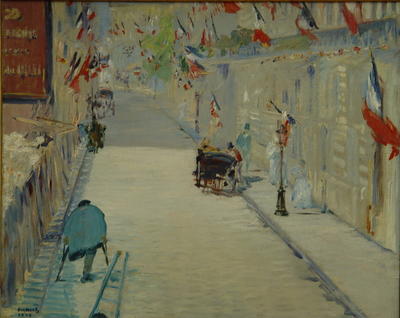Bastille Day

"Rue Mosnier with Flags"
Édouard Manet
25 3/4 x 31 3/4 in. oil on canvas 1878
On a day of national celebration in France, the Getty Museum's collection of French paintings provides a link to Paris.
The AP reports today that Brazilian President Luiz Inacio Lula da Silva, the guest of honor, joined French President Jacques Chirac on the official reviewing stand at the Place de la Concorde to view the Bastille Day Parade. Brazilian President Silva was invited to the observances as part of "the year of Brazil in France," which aims to promote economic and cultural ties between the two countries.
After the parade finished, Chirac and Silva stood at attention outside the presidential Elysee Palace as sirens sounded across Paris to observe two minutes of silence in solidarity with London.
Manet's "Rue Mosnier" was painted two years before July 14th was declared the French national holiday in 1880. The holiday is known as the Fête Nationale in France and commemorates the Fête de la Fédération of 1790, held on the first anniversary of the storming of the Bastille prison in Paris by an angry mob on 14 July 1789, sparking the revolution that rid France of its monarchy.
From the Getty's description of Manet's " Rue Mosnier with Flags":
" The French government declared June 30, 1878, a national holiday: Fête de la Paix (Celebration of Peace) which marked France's recovery from the disastrous Franco-Prussian War of 1870-1871 and the divisive Paris Commune that followed. From his studio's second--floor window, Édouard Manet captured the holiday afternoon with his fluid brushwork in a harmony of the reds, whites, and blues of the French tricolor.
The urban street was a principal subject of Impressionist and Modernist painting; many artists aimed to show not only the transformation and growth of the Industrial Age but how it also affected society. Manet's eyes saw both elegant passengers in hansom cabs and, in the foreground, a worker carrying a ladder. The hunched amputee on crutches, perhaps a war veteran or beggar, passes by fenced-in debris left from the construction of a new train track. Manet's sensitivity to the associated costs and sacrifices tempered his optimistic view of national pride and newfound prosperity."
Modernkicks has more on the birth of Liberté.

0 Comments:
Post a Comment
<< Home